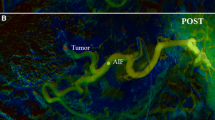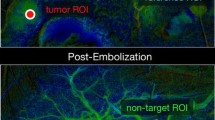Abstract
Purpose
To quantify the arterial flow change during transcatheter arterial chemoembolization (TACE) for hepatocellular carcinoma (HCC) using digital subtraction angiography, quantitative color-coding analysis (d-QCA), and real-time subtraction fluoroscopy QCA (f-QCA).
Materials and Methods
This prospective study enrolled 20 consecutive patients with HCC who had undergone TACE via a subsegmental approach between February 2014 and April 2015. The TACE endpoint was a sluggish antegrade tumor-feeding arterial flow. d-QCA and f-QCA were used for determining the relative maximal density time (rTmax) of the selected arteries. The rTmax of the selected arteries was analyzed in d-QCA and f-QCA before and after TACE, and its correlation in both analyses was evaluated.
Results
The pre- and post-TACE rTmax of the embolized segmental artery in d-QCA and f-QCA were 1.59 ± 0.81 and 2.97 ± 1.80 s (P < 0.001) and 1.44 ± 0.52 and 2.28 ± 1.02 s (P < 0.01), respectively. The rTmax of the proximal hepatic artery did not significantly change during TACE in d-QCA and f-QCA. The Spearman correlation coefficients of the pre- and post-TACE rTmax of the embolized segmental artery between d-QCA and f-QCA were 0.46 (P < 0.05) and 0.80 (P < 0.001). Radiation doses in one series of d-QCA and f-QCA were 140.7 ± 51.5 milligray (mGy) and 2.5 ± 0.7 mGy, respectively.
Conclusions
f-QCA can quantify arterial flow changes with a higher temporal resolution and lower radiation dose. Flow quantification of the embolized segmental artery using f-QCA and d-QCA is highly correlated.



Similar content being viewed by others
References
Parkin DM, Bray F, Ferlay J, Pisani P. Global cancer statistics. CA Cancer J Clin. 2002;55:74–108.
Llovet JM, Real MI, Montaña X, Planas R, Coll S, Aponte J, et al. Arterial embolisation or chemoembolisation versus symptomatic treatment in patients with unresectable hepatocellular carcinoma: a randomised controlled trial. Lancet. 2002;359(9319):1734–9.
Lo C-M, Ngan H, Tso W-K, Liu CL, Lam CM, Poon RT, et al. Randomized controlled trial of transarterial lipiodol chemoembolization for unresectable hepatocellular carcinoma. Hepatology. 2002;35(5):1164–71.
Jin B, Wang D, Lewandowski RJ, Ryu RK, Sato KT, Larson AC, et al. Quantitative 4D transcatheter intraarterial perfusion MRI for standardizing angiographic chemoembolization endpoints. Am J Roentgenol. 2011;197(5):1237–43.
Maeda S, Fujiyama S, Tanaka M, Ashihara H, Hirata R, Tomita K. Survival and local recurrence rates of hepatocellular carcinoma patients treated by transarterial chemolipiodolization with and without embolization. Hepatol Res. 2002;23(3):202–10.
Ikeda M, Maeda S, Shibata J, Muta R, Ashihara H, Tanaka M, et al. Transcatheter arterial chemotherapy with and without embolization in patients with hepatocellular carcinoma. Oncology. 2004;66(1):24–31.
Takayasu K, Arii S, Ikai I, Kudo M, Matsuyama Y, Kojiro M, et al. Overall survival after transarterial lipiodol infusion chemotherapy with or without embolization for unresectable hepatocellular carcinoma: propensity score analysis. Am J Roentgenol. 2010;194(3):830–7.
Jin B, Wang D, Lewandowski RJ, Riaz A, Ryu RK, Sato KT, et al. Chemoembolization endpoints: effect on survival among patients with hepatocellular carcinoma. Am J Roentgenol. 2011;196(4):919–28.
Kim YB, Park YN, Park C. Increased proliferation activities of vascular endothelial cells and tumour cells in residual hepatocellular carcinoma following transcatheter arterial embolization. Histopathology. 2001;38(2):160–6.
Poon RT, Lau C, Yu WC, Fan ST, Wong J. High serum levels of vascular endothelial growth factor predict poor response to transarterial chemoembolization in hepatocellular carcinoma: a prospective study. Oncol Rep. 2004;11(5):1077–84.
Sergio A, Cristofori C, Cardin R, Pivetta G, Ragazzi R, Baldan A, et al. Transcatheter arterial chemoembolization (TACE) in hepatocellular carcinoma (HCC): the role of angiogenesis and invasiveness. Am J Gastroenterol. 2008;103(4):914–21.
Lin YY, Lee RC, Tseng HS, Liu CA, Guo WY, Chang CY. Objective measurement of arterial flow before and after transcatheter arterial chemoembolization: a feasibility study using quantitative color-coding analysis. Cardiovasc Intervent Radiol. 2015;38(6):1494–501.
Lieber BB, Sadasivan C, Hao Q, Seong J, Cesar L. The mixability of angiographic contrast with arterial blood. Med Phys. 2009;36(11):5064–78.
Shpilfoygel SD, Close RA, Valentino DJ, Duckwiler GR. X-ray videodensitometric methods for blood flow and velocity measurement: a critical review of literature. Med Phys. 2000;27(9):2008–23.
Hodgson JM, LeGrand V, Bates ER, Mancini GB, Aueron FM, O’Neill WW, et al. Validation in dogs of a rapid digital angiographic technique to measure relative coronary blood flow during routine cardiac catheterization. Am J Cardiol. 1985;55(1):188–93.
Bates ER, Vogel RA, LeFree MT, Kirlin PC, O’Neill WW, Pitt B. The chronic coronary flow reserve provided by saphenous vein bypass grafts as determined by digital coronary radiography. Am Heart J. 1984;108:462–8.
Simon R, Herrmann G, Amende I. Comparison of three different principles in the assessment of coronary flow reserve from digital angiograms. Int J Card Imaging. 1990;5(2–3):203–12.
Ionita CN, Garcia VL, Bednarek DR, Snyder KV, Siddiqui AH, Levy EI, et al. Effect of injection technique on temporal parametric imaging derived from digital subtraction angiography in patient specific phantoms. Proc SPIE Int Soc Opt Eng. 2014;13(9038):90380L.
Kennedy AS, Kleinstreuer C, Basciano CA, Dezarn WA. Computer modeling of yttrium-90-microsphere transport in the hepatic arterial tree to improve clinical outcomes. Int J Radiat Oncol Biol Phys. 2010;76(2):631–7.
Ersahin A, Molloi SY, Hicks JW. Absolute phasic blood flow measurement in the brain using digital subtraction angiography. Invest Radiol. 1995;30(4):244–53.
Bonnefous O, Pereira VM, Ouared R, Brina O, Aerts H, Hermans R, et al. Quantification of arterial flow using digital subtraction angiography. Med Phys. 2012;39(10):6264–75.
Acknowledgments
The authors acknowledge the support provided by Taipei Veterans General Hospital and Siemens Healthcare (Grant number: T1100200).
Author information
Authors and Affiliations
Corresponding authors
Ethics declarations
Conflict of Interest
Dr. Chu reports grants from Siemens Healthcare for a collaboration contract between Taipei Veterans General Hospital and Siemens Healthcare during the conduct of the study. Frank Chun-Hsien Wu and Sonja Gehrisch are employees of Siemens Healthcare. On behalf of all authors, the corresponding author states that there is no conflict of interest.
Statement of Informed Consent
Informed consent was obtained from all individual participants included in the study.
Statement of Human Right
All procedures performed in studies involving human participants were in accordance with the ethical standards of the institutional research committee and with the 1964 Helsinki declaration and its later amendments or comparable ethical standards.
Rights and permissions
About this article
Cite this article
Lin, YY., Lee, RC., Guo, WY. et al. Quantitative Real-Time Fluoroscopy Analysis on Measurement of the Hepatic Arterial Flow During Transcatheter Arterial Chemoembolization of Hepatocellular Carcinoma: Comparison with Quantitative Digital Subtraction Angiography Analysis. Cardiovasc Intervent Radiol 39, 1557–1563 (2016). https://doi.org/10.1007/s00270-016-1421-3
Received:
Accepted:
Published:
Issue Date:
DOI: https://doi.org/10.1007/s00270-016-1421-3




